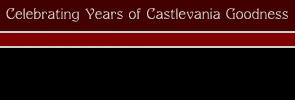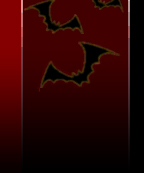|
Castlevania (1987)

Castlevania. For many Nintendo Entertainment System players, this landmark title was the beginning of the saga that we now know today. The premise, like many Nintendo games at the time, was simple: take control of the whip-wielding hero Simon Belmont as he trekked through six stages of Count Dracula's castle. You know the basics: walk forward, whip candles, upgrade your weapon, destroy enemies, kill the nasty boss at the end of the level.
Though it does lack some of the gameplay enhancements of later Castlevania titles, it has actually held up against the test of time quite well. Graphically, the game isn't horribly stunning, though everything was rather detailed for the time. Simon, oddly enough, is composed mostly of browns, giving him a bizarre look. However, the music is outstanding. I'm still dumbfounded how the Konami sound composers could create such catchy tunes with the early sound of the NES synthesizer. Everything from the classic opening level tune to the spooky underground water level music to Dracula's theme broods with not only atmosphere but also great melody. And the sound effects, especially in 1987, just rocked. Who can forget the sound of Simon grunting when hit? Or the burning of the "fire bomb" (known as the Holy Water, dubbed as such since Nintendo didn't want any religious connotations)? Hell, even the swish of your whip or the sound of heart collections are memorable, even today.
There are some gameplay problems that many people have complained about however, and the worst of which is the stiff play control. Once you jump, you can't change directions in mid-air. The whip isn't exactly the most wieldy of weapons, and hitting smaller objects (especially the annoying floating Medusa heads) requires near exact timing. And when you're hit by an enemy, it's quite common that you'll fly backward right into a pit. These little play control quirks have plagued much of the series to various degrees, as well.
The other main problem is the difficulty. At the beginning of the game, you can take eight before you die, but enemies grow stronger as the game progresses. By the time you get to the end of level four, get hit but four times and you're dead. The difficulty of many of the bosses, primarily Frankenstein and the Grim Reaper, have sent people to the madhouse, and the fight against Dracula is perhaps one of the most difficult in gaming history (it took me at least four hours and God-knows-how-many attempts to finally beat him.) Fortunately, you do get unlimited continues, but this game takes lots of patience.
Yes, it's old, and yes, it's tough. But dammit, Castlevania is a true classic, the type that brings fond tears to my eyes whenever I think about it (well, a bit of an exaggeration, but you get the idea.) The beginning of the Castlevania legend is right here.
Although initially released for the NES, it also had many ports to other computer platforms, including the PC, Commodore 64 and Amiga. There was also an arcade game called Vs. Castlevania. Check them out on the Weirdness page.
Japanese Famicom Manual Scans provided by Proto. Famicom Mini Scans from Carlo Salvorelli.
Castlevania Artwork

Back to Top
Castlevania Games - Castlevania
|
|
|



